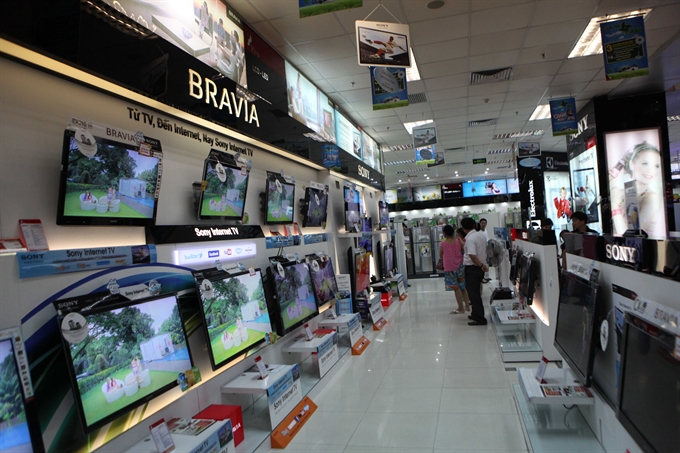 Economy
Economy

Việt Nam’s consumption of electronic and electrical appliances is expected to rise from 7.3 per cent to 11.9 per cent by 2020, thanks to a new focus on its youthful consumers.
 |
| Customers shop for electronic devices at a Pico electronics market. Việt Nam’s consumption of electronics and electrical appliances is expected to rise from 7.3 per cent to 11.9 per cent by 2020. - VNS Photo Trương Vị |
HÀ NỘI – Việt Nam’s consumption of electronic and electrical appliances is expected to rise from 7.3 per cent to 11.9 per cent by 2020, thanks to a new focus on its youthful consumers.
Market research results from GFK Retail and Technology Market Research Vietnam Limited show that improvement in average earnings has greatly affected household consumption expenditure, especially in household electrical and electronic appliances. The country’s GDP per capita topped US$2,109 last year, but household expenditure will increase to around $3,737 per household per annum.
Besides, local rising demand in the electronic and electrical retail markets has not been fully tapped. The retail market in Việt Nam has currently only satisfied 25 per cent of the demand. The figure is estimated to reach about 45 per cent in 2020.
Expenditure on electronic and electrical appliances alone is estimated at around VNĐ157 trillion ($6.8 billion), of which, electronic products accounts for VNĐ60 trillion, led by mobile phones, notebooks and tablets. Meanwhile, household electrical products accounted for VNĐ97 trillion with flat-screen televisions dominating, followed by air conditioners, fridges and washing machines.
Đặng Trần Hải Đăng, deputy director of VietinbankSc Research Centre, explained that Việt Nam has become an official member of a number of free trade agreements, including EU-Việt Nam, Việt Nam–South Korea, the Trans Pacific Partnership, and recently the ASEAN Economic Community.
The Ministry of Finance has prepared a list of import tariffs to reduce to zero for all imported items from member countries. Firstly, high-quality electronic and electrical products from Japan, South Korea, and Thailand are entering into Việt Nam with competitive prices. This will boost domestic consumption in the future.
Although domestic demand for electronic and electrical products is increasing rapidly, the retail distribution network is only in the hands of a few enterprises and in big cities. A market survey by VietinbankSc says that in the genuine mobile phone market, Thế Giới Di Động accounts for 30 per cent of market share, FPT 10 per cent, provincial stores and electronics supermarkets 20 per cent, and small mobile phone stores 40 per cent.
As for the electronics market, there are fewer distributors but on a larger scale, including Home Center, Nguyễn Kim, Điện Máy Xanh, Điện Máy Chợ Lớn, Pico, Trần Anh and MediaMart. In May last year, leading Vietnamese property firm Vingroup also entered the consumer electronics retailing sector with the introduction of the brand VinPro.
Vingroup set a target to bring the total number of VinPro and VinPro+ stores to 25 and 100, respectively, last year.
According to Huỳnh Phước Cường, retail director of GFK, foreign investors opt for buying well-known and prestigious distribution networks and stores instead of building a new risky distribution network. At present, legal factors allow them to carry out this objective easily.
Power Buy Company Limited, a company of Thailand’s Central Group, has already acquired a 49 per cent stake in Nguyễn Kim Trading Joint Stock Company, one of the biggest home appliance store chains in Việt Nam. In addition, Central Group has also bought a 49 per cent stake of Pico. Japanese corporations owned a 49 per cent stake, a 91 per cent stake, and a 30 per cent stake of Citimart, Trần Anh, and Fivimart respectively. A few shopping centers have been bought by investors from South Korean and Hong Kong.
With the market is changing so rapidly, concerns have been raised whether Vietnamese businesses will be able to withstand the intrusion of experienced and rich competitors from other countries. Deputy Minister of Industry and Trade, Trần Quốc Khánh, said that there will still be a place for small businesses as long as they are proactive and learn to adapt to the new situation. -- VNS




